Wildlife gardening is an eco-conscious practice that allows you to create a haven for local wildlife right in your own backyard. By cultivating a wildlife garden, you contribute to biodiversity and ecosystem health. It involves integrating sustainable gardening practices to support a variety of species, from the tiniest insects to visiting birds and mammals.
The key is to mimic natural processes and provide the essentials: food, shelter, and water. You create not just aesthetic appeal but a functional habitat that enhances the local environment and helps in conserving nature.

As you plan your wildlife garden, choose native plants that naturally support local wildlife. These plants require less maintenance and are better adapted to your climate, reducing the need for watering and fertilizers.
By fostering an environment where wildlife thrives, you directly contribute to climate resilience and the support of your area’s natural world. A sustainable approach to gardening, such as using organic pest control and minimizing the use of chemicals, ensures that your garden is a safe refuge for visiting creatures.
Creating a certified wildlife habitat within your garden not only benefits the environment but also provides endless opportunities for education and enjoyment. Witnessing the daily happenings of the birds, butterflies, and other wildlife that come to visit can be deeply rewarding.
It’s a living space that constantly evolves, and as you learn more about the interconnectedness of species, you’ll find that a wildlife garden is more than just a piece of land—it’s a thriving, vibrant ecosystem.
Bird-Friendly Bushes
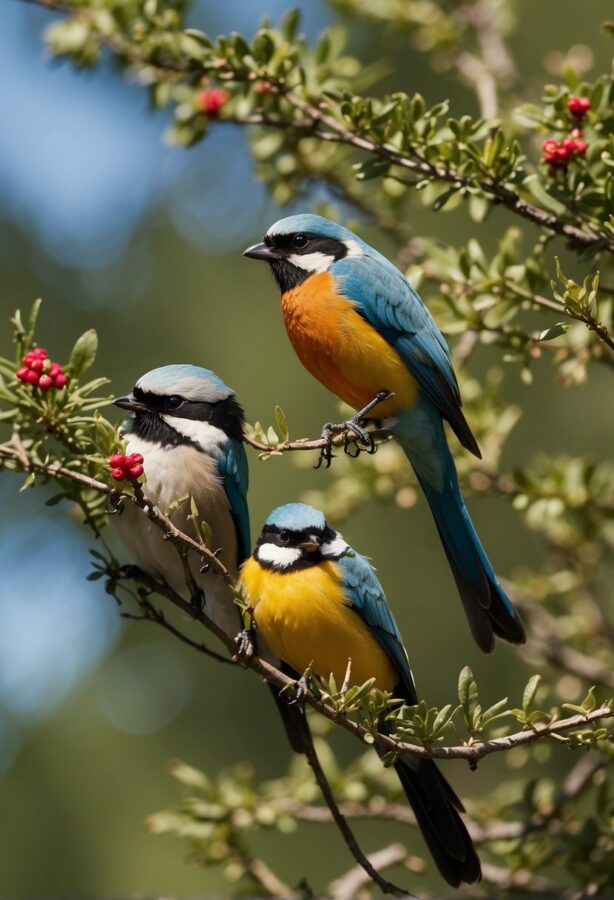
Creating a wildlife habitat in your garden goes beyond aesthetics; it supports the local ecosystem. When selecting bushes, consider those providing food, shelter, and cover for birds. Your choices should ideally contribute to a balanced ecosystem, favoring native plant species to offer the best support for local wildlife.
Native Berries:
Utilize bushes like Holly, which produce berries relished by birds. These bushes serve as natural food sources and attract a variety of bird species.
- Holly (Ilex spp.): Bird-friendly and offers bright red berries and cover.
Nectar-Rich Bushes:
Select bushes with nectar-filled flowers to invite birds and play a crucial role for pollinators like bees and butterflies.
- Trumpet Honeysuckle (Lonicera sempervirens): Rich in nectar, attracting hummingbirds and other nectar-feeders.
Planting for Shelter:
Your garden can offer vital shelter to birds through thick foliage and robust branches. Consider adding bushes that provide dense cover.
- Serviceberry (Amelanchier spp.): Offers both cover and food with its edible berries.
When planning your bird-friendly garden, avoid the use of pesticides or chemicals, as these can harm the very wildlife you aim to attract and support. Instead, encourage a natural balance by planting a mix of bushes that cater to the different needs of birds throughout the year.
Hedgerows for Habitat:
A hedgerow combining a variety of bushes can act as a mini wildlife corridor, providing birds with a safe space to feed and nest.
- Spicebush (Lindera benzoin): A native shrub that provides shelter and berries for birds.
By thoughtfully selecting bushes and considering their impact on local wildlife, you can turn your garden into a thriving habitat for birds and other creatures, enhancing biodiversity and promoting a more eco-friendly environment.
See Related: Capturing the Wild: Renowned Wildlife Photographers to Follow
Butterfly Gardens
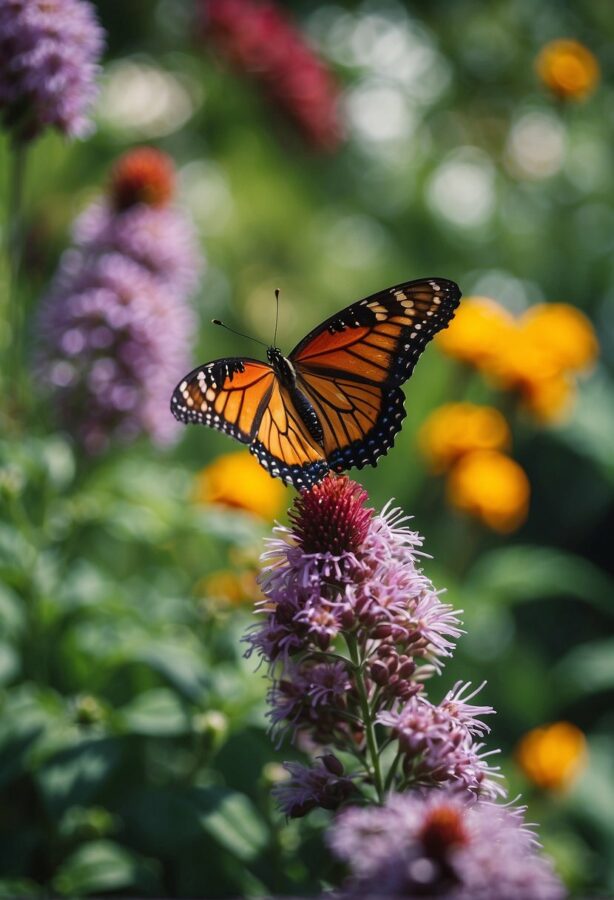
Creating a butterfly garden is a fulfilling eco-friendly endeavor that not only brings beauty to your yard but also supports local wildlife. When you begin your garden, select native plants which are more likely to thrive in your area and provide the best support for native butterflies and moths.
Choosing the Right Flowers
- Nectar-rich flowers such as milkweed, lavender, and zinnias are essential to feed adult butterflies.
- Opt for flowers with varied blooming times to ensure a continuous food supply.
- Select flowers in vibrant hues of red, yellow, orange, pink, or purple. Flat-topped or clustered blooms with short tubes are ideal.
Creating a Favorable Habitat
- Your garden should cater to both adult butterflies and their larvae. Incorporate diverse plant species to cater to different butterfly life stages.
- Sunlight is crucial; butterflies need it for body temperature regulation. Place nectar plants where they’ll receive full sun from mid-morning to mid-afternoon.
Supporting Broader Wildlife
- Beyond butterflies, your garden can sustain various wildlife. By including water sources and plants that produce seeds, you’re able to support birds and small animals.
- Establish a focal point such as a bird bath or a bench amidst the butterfly-friendly flora to observe and enjoy the bustling activity of your garden.
Remember to employ organic gardening practices. Refrain from using pesticides, which can harm the very creatures you’re aiming to attract. Through the thoughtful layout of your butterfly garden, you are championing biodiversity and offering a haven for local species to flourish.
Frog Ponds

Creating a frog pond in your garden is a fantastic eco-friendly way to support local wildlife and contribute to a thriving wildlife habitat. Providing a water feature for amphibians, such as frogs and toads, as well as for newts and dragonflies, can make a significant environmental impact.
To start, select a spot for your pond that gets both sun and shade during the day. Frogs prefer cool places to retreat to when it gets too warm.
Dig a hole at least one foot deep to ensure that it won’t dry out too quickly, but no more than three feet to keep it safe for wildlife. Gradually slope the sides to allow easy access for animals.
Water and Pond Liner: Ensure your pond’s water is de-chlorinated, since chlorine can harm amphibians. You can fill the pond with a hose and wait 48 hours for the chlorine to evaporate. To retain water, line the hole with a pond liner.
Rocks and Logs: Add submerged rocks and logs to provide hiding and resting spots.
Plants: Introduce native aquatic plants which will oxygenate the water and offer additional cover. Use pots with a gravel layer to prevent the soil from clouding the water.
Table: Recommended Plants for Frog Ponds
Emergent Plants | Submerged Plants |
|---|---|
Marsh Marigold | Hornwort |
Water Mint | Waterweed |
Lastly, place a few stones or a pile of logs nearby to create a diverse habitat. This not only supports your pond’s inhabitants but can also attract other small mammals and birds who may come to drink or bathe. Remember, your efforts in building a frog pond extend the habitat beyond just the water, contributing to the wider ecosystem in your own backyard.
Bee Havens
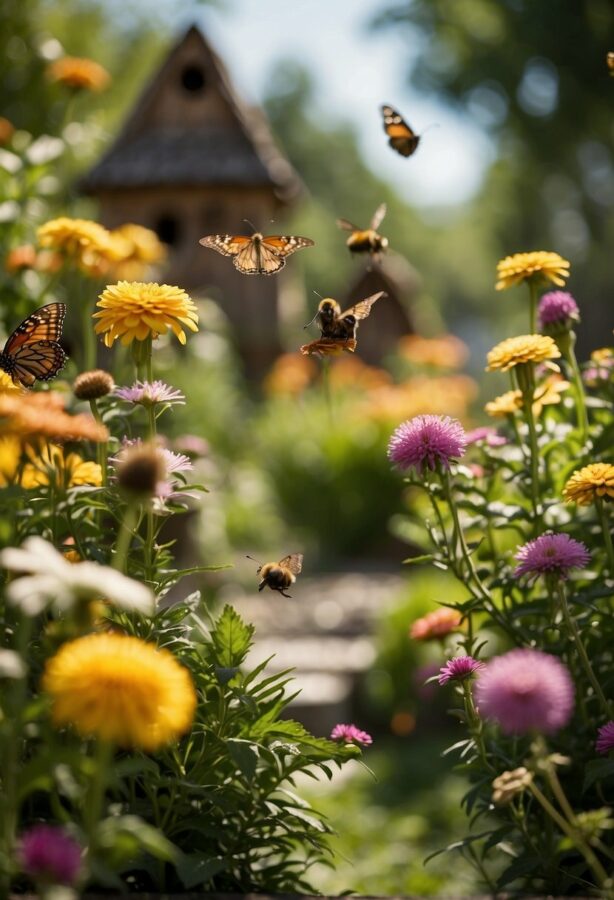
Creating a bee haven in your wildlife garden not only provides vital support for these important pollinators but also enhances the biodiversity of your outdoor space. Bees require two main components in their habitat: a source of nectar and pollen, and a safe place to nest.
Plant Native Wildflowers: Opt for a variety of native plants, which tend to attract more bees than non-natives. Group flowers together to make them easier to find. Bees are especially drawn to flowers that are blue, purple, and yellow. Consider planting wildflowers which often require less maintenance and are well-suited to the local climate and soil, supporting your local bee populations effectively.
Provide Shelter with Bee Houses: Augment your garden with a bee house to offer a secure nesting site. Place the bee house in a sunny, south-facing spot but sheltered from extreme weather. You can make one from a pile of logs or buy a bespoke house.
Practice Companion Planting: Integrate flowering plants amongst your vegetables to attract pollinators. Not only does this method aid in pollination, but it also helps to protect your crops naturally, reducing the need for pesticides.
Avoid Pesticides: Chemicals can harm bees and other beneficial insects. Utilize organic gardening practices and natural pest control methods to minimize impact on the ecosystem.
Continuous Blooming: Ensure that your garden has plants flowering at different times throughout the season to provide a constant source of food for bees.
By incorporating these eco-friendly gardening practices, you’re not just beautifying your space but also contributing to the conservation of bees and enhancing local biodiversity.
Hedgehog Hideouts
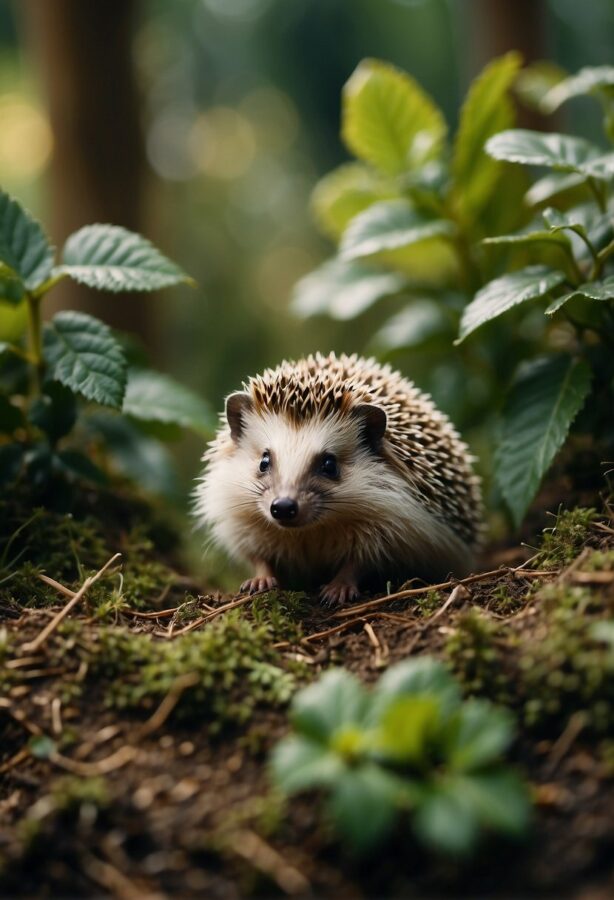
Creating a haven for hedgehogs in your wildlife garden can significantly support these charming creatures. Hedgehogs require snug shelters for resting and hibernation, which contribute to a thriving wildlife habitat. These tips will guide you in crafting the perfect hideouts in your eco-friendly garden.
Location: Choose a quiet, sheltered corner of your garden for the hedgehog house. This should be away from frequent human activity to provide a sense of security for the hedgehogs.
Materials:
- Structure: You can use a simple wooden box or purchase a specially designed hedgehog house.
- Bedding: Line the shelter with dry leaves, hay, or straw to offer a warm, cozy bed.
Garden Access:
- Ensure there are gaps in your fences or hedges, about 13x13cm, to allow hedgehogs to freely enter and exit.
Additional Tips:
- Plant dense hedges or borders to offer natural cover and a supply of insects, slugs, and snails, which are staple food sources for hedgehogs.
- Avoid using netting or mesh that hedgehogs can get tangled in; if you must use it, keep it at least a foot off the ground.
- Maintain a compost heap, which provides both a food source and potential nesting site.
- Regularly leave out fresh water and supplementary hedgehog food, especially during dry spells.
By integrating these elements into your wildlife gardening practices, you establish a welcoming environment for hedgehogs and contribute to the eco-friendly ethos of supporting local wildlife.
Squirrel Playgrounds

Creating a squirrel playground in your garden is an eco-friendly way to support local wildlife, specifically the energetic and acrobatic squirrels.
Provide Food Sources
- Sunflower seeds: Offer a bountiful supply to attract squirrels.
- Unroasted peanuts and field corn kernels: Place these in trays or squirrel feeders.
Establish Nesting Sites
- Nesting boxes: Install boxes that measure approximately 7×7 inches at the base and 8-10 inches in height, with an entrance hole of 4-6 inches in diameter.
- Trees: Preserve mature trees which provide natural nesting sites and cover.
Ensure Shelter and Cover
- Planting shrubs and thickets: These provide safety and shelter for squirrels from predators.
- Maintain a layer of leaves or mulch: Offers ground cover for foraging squirrels.
Create Obstacle Courses
- Include ropes and mini bobsled tunnels: Opportunities for squirrels to exercise and play in your garden.
Supporting Wildlife Habitat
- Let fallen branches lie: They can serve as additional shelter and play structures.
- Keep a section of your garden wild: Let it grow naturally to mimic squirrels’ natural habitat.
By implementing these squirrel-friendly features, you’re not just providing entertainment; you are enhancing the overall wildlife habitat, offering food, shelter, nesting sites, and a sanctuary for these mammals to thrive in your eco-friendly garden.
See Related: Eco-Friendly Pet Products for a Greener Home
Bat Boxes

Incorporating a bat box into your garden is a stellar way to bolster local ecosystems. Bats are vital for maintaining healthy insect populations and pollinating native plants, but they often lack shelter. Here’s how you can help:
Placement: Position your bat box at least 15 feet high, facing southeast to south to catch the morning sun. Avoid artificial light and ensure it has a clear flight path.
Design: Your bat box should be at least 24 inches tall and 16 inches wide to provide adequate thermal stability. Use untreated, rough-sawn wood to create roosting boards and a landing pad, as bats need a textured surface to cling onto.
Materials: Opt for durable wood or woodstone to ensure longevity and prevent drafts.
Do’s | Don’ts |
|---|---|
Use rough wood | Include fabric or mesh |
Ensure proper ventilation | Use toxic paint or varnish |
Respect size recommendations | Disturb the box once occupied |
Creating Habitat: Surround your bat box with native plants that attract insects. This not only provides food for your nocturnal guests but also increases the chances of pollination.
Maintenance: Once a year, during the fall or winter when bats are not present, check the integrity of the box, making sure it remains secure and inviting for its mammalian inhabitants.
By installing a bat box and fostering a wildlife-friendly space, you offer bats shelter while enhancing your garden’s ecological role. It’s a positive step toward an eco-friendly approach to gardening, beneficial for both you and your flying friends.
Native Wildflowers

Incorporating native wildflowers into your garden not only adds splashes of color and natural beauty but plays a critical role in supporting local ecosystems. Wildflowers are valuable for their ability to attract and nourish a variety of pollinators, such as bees, butterflies, and birds. By choosing wildflowers that thrive in your region, you provide food sources like nectar and pollen that are essential for these pollinators.
Attracting Wildlife: Meadows brimming with native plants can sustain diverse wildlife. Small insects and larger animals thrive when biodiversity is high, and wildflowers are an integral part of such habitats.
Creating a Wildflower Meadow: You can transform your lawn into a vibrant wildflower meadow by sowing a mixture of seeds that suit your local climate. This will not only enhance the aesthetic appeal but create a haven for various species, enriching the wildlife garden.
Choosing the Right Plants: Utilize tools like the Native Plant Finder to discover species that thrive in your area. This not only ensures growth success but also helps cater to the specific tastes of local fauna.
Benefiting the Entire Food Web: Wildflowers support not just the insects that feed directly on them but the entire food web. Birds, for instance, rely on the insects that feed on wildflowers to sustain themselves and their young.
By integrating native wildflowers into your garden, you’re doing more than beautifying your space; you’re contributing to the conservation of native plants and supporting the insects and animals that depend on them. Ensure the vitality of your wildlife garden by planting a diverse selection of native plants to provide pollen, nectar, and seed resources year-round.
See Related: Discover the Fascinating World of Animals: Learn Amazing Facts and Stories
Insect Hotels
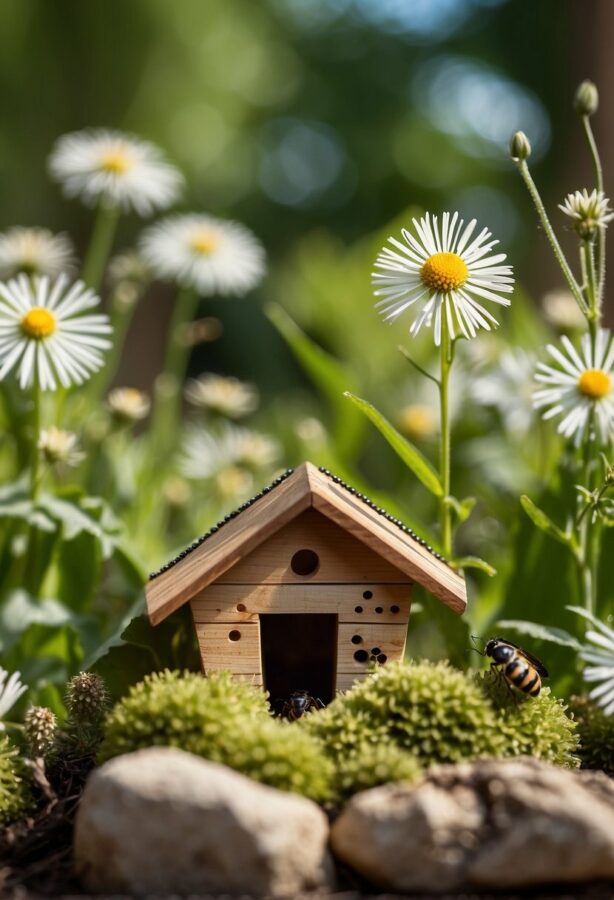
Insect hotels are a practical addition to your wildlife garden, offering cozy habitats for various beneficial insects. By creating these shelters, you contribute to biodiversity and support eco-friendly practices.
Location & Conditions
- Situate your insect hotel in a shaded, warm part of the garden like near a brick wall, away from strong winds and rain.
- Ensure it’s near nectar-producing plants to attract pollinators.
Materials & Construction
- Use a variety of natural materials such as straw, bamboo, and pine cones. These create a diverse range of nesting options for insects.
Table 1: Materials and Insect Guests
Material | Insect Guests |
|---|---|
Bamboo Tubes | Bees, Wasps |
Pine Cones | Beetles, Spiders |
Straw Bundles | Butterflies, Moths |
- Assemble with eco-friendly methods, avoiding chemicals that could harm wildlife.
Creating Habitats
- Layer your materials inside a wooden frame or box to give structure and cover.
- Drill holes in logs for bees, ensuring a variety of diameters for different species.
- Stack bricks or rocks for ground-dwelling species.
Ongoing Care
- Avoid using pesticides near your insect hotel.
- Monitor your hotel throughout the year and make repairs as needed to keep it inviting.
By investing time in constructing and maintaining insect hotels, you provide essential shelter for pollinators and other insects which are crucial for a thriving eco-system in your garden. This small step significantly impacts local wildlife, from pollinators like bees and butterflies to a host of other beneficial species.
Seasonal Planting for Wildlife
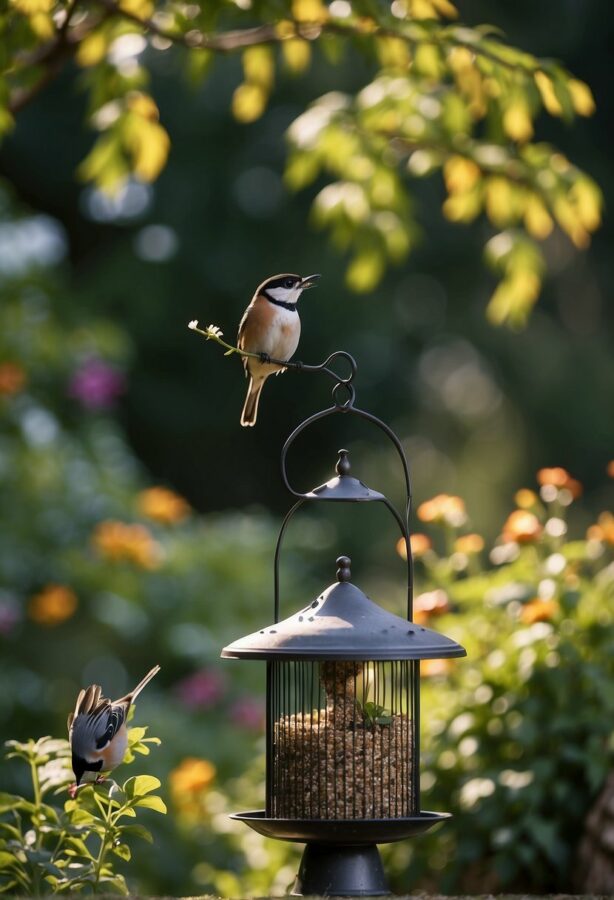
Creating a wildlife garden is a fulfilling way to contribute to local ecosystems and support biodiversity. To do this effectively, you should focus on seasonal planting which provides sustenance and habitat for wildlife throughout the year.
Spring
In spring, your garden should burst with native flowers like milkweed and lupine, which supply ample nectar for early pollinators. Planting wildflowers that bloom in succession ensures a consistent food source.
Native Plants for Spring:
- Milkweed (Asclepias spp.)
- Lupine (Lupinus spp.)
- Columbine (Aquilegia spp.)
Summer
During summer, focus on plants that produce berries and seeds, which many bird species rely on. Consider adding fruit-bearing shrubs and flowers that can tolerate the heat and attract a variety of insects and birds.
Native Plants for Summer:
- Sunflower (Helianthus spp.)
- Black-eyed Susan (Rudbeckia hirta)
- Coneflower (Echinacea spp.)
Autumn
As the seasons change, so do the needs of local wildlife. Goldenrod and aster provide late blooms, offering pollen and nectar for insects preparing for winter. The foliage also serves as overwintering sites for beneficial insects.
Native Plants for Fall:
- Goldenrod (Solidago spp.)
- Aster (Symphyotrichum spp.)
- Joe-Pye weed (Eutrochium spp.)
Winter
Even in winter, your garden can be a refuge by offering shelter and food. Evergreen plants and those with seed heads left intact can be valuable food sources and maintain habitat structure.
Native Plants for Winter:
- Holly (Ilex spp.)
- Juniper (Juniperus spp.)
- Witch Hazel (Hamamelis virginiana)
Using sustainable gardening practices, like composting and avoiding chemicals, enhances soil health and supports a more resilient ecosystem. Companion planting can naturally deter pests, reducing the need for intervention and fostering a balanced food chain.
Moreover, incorporating native plants minimizes the spread of weeds and provides essential green spaces for urban wildlife. Remember, your choices support the intricate web of life right in your backyard.
Related Resources: